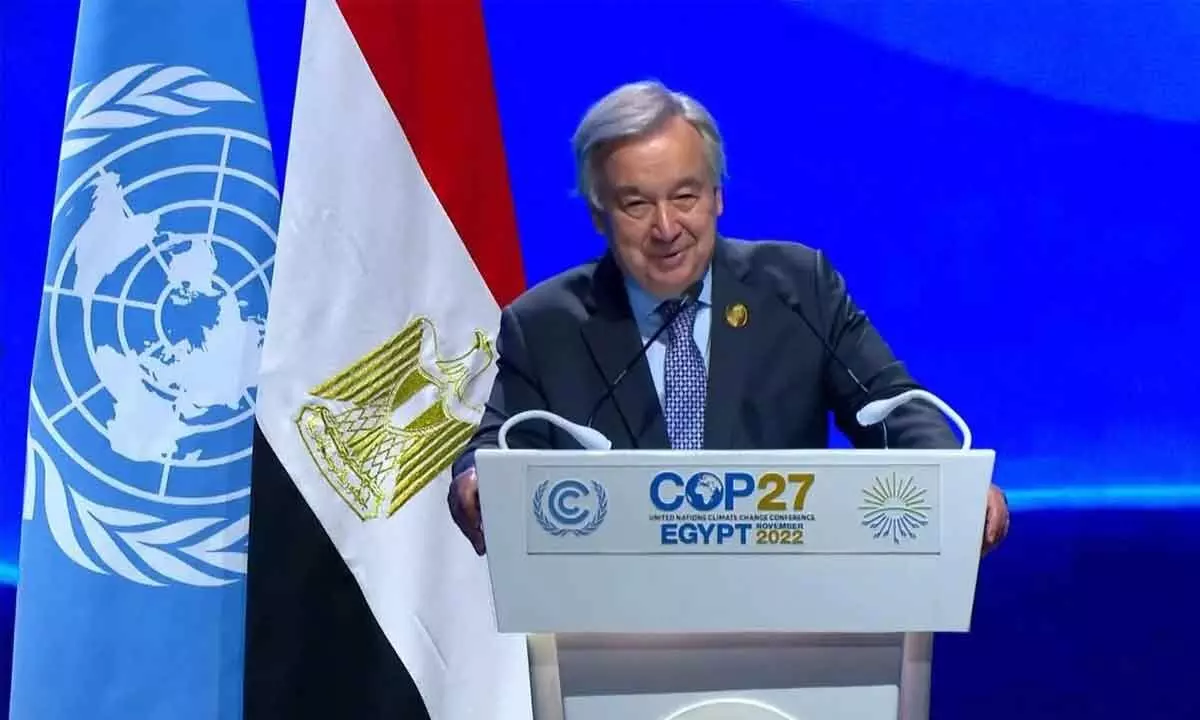India needs to add shine to its future

In his opening remarks at COP27, Antonio Guterres, the U.N. Secretary General, gave a warning - "We are in the fight of our lives, and we are losing."We are on a highway to climate hell with our foot on the accelerator."
In his opening remarks at COP27, Antonio Guterres, the U.N. Secretary General, gave a warning - "We are in the fight of our lives, and we are losing."We are on a highway to climate hell with our foot on the accelerator."
There is no gain saying that there is a strong case for an enhanced thrust to renewal energy for reduction of the carbon footprint and attempt to slowing down the climate change. For India, it will come with the multiple benefits - reduced dependence on imports of oil and coal, reduced pressure of forex reserves, earning tradeable carbon credits and global leadership in fighting climate change.
India is blessed with a huge potential for harnessing solar power. India added a record 10 Gigawatt (GW) of solar energy to its cumulative installed capacity in 2021. This has been the highest 12-month capacity addition, recording nearly a 200 per cent year-on-year growth. India has now a cumulative installed solar capacity of 59 GW as on August 31, 2022. This is a milestone in India's journey towards meeting the renewable target set for by 2030 and generating 50 per cent of it from solar power.
Solar power generation capacity in India is now contributing nearly 6.5 per cent of the global cumulative capacity of slightly over 700 GW. India generated over 70 billion units in the first nine months of 2022, an increase of 36 per cent over the corresponding period last year. However, the total generation of power is now over 1600 billion units and far more needs to be done quickly to increase share of solar. India has also achieved a record low tariff for solar power generation of Rs 1.99 per unit.
Domestic manufacturing capacities of solar cells and modules are far short of targets for solar power generation in the country. According to research published by Mercom India, domestic module manufacturing capacity was around 18-20 GW. In 2021-22, India imported nearly $76.62 billion worth solar cells and modules from China, accounting for 78.6 per cent of India's total imports in the year.
Moreover, backward integration in the solar value chain is absent as India has no capacity for manufacturing solar wafers and polysilicon. Other ancillary industries such as for tempered glass, EVA sheets, Aluminium frames and junction boxes are in nascent stages.
In order to simultaneously achieve the objective of augmenting solar power generation, through domestically manufactured solar cells and panels, the Government raised customs duties on solar cells to 25 per cent and modules to 40 per cent. This move is retrograde since sufficient capacities for manufacture of solar cells are not likely to come on stream in the next 10 years. If India is to achieve a generation of at least 200 billion units in next 2 years unrestricted, duty free imports of PVs are a must.
This was, in manner of speaking, a classic case of "Guns Vs Butter". In a setting where India wishes to multiply its capacity by five times in the next seven years, it is faced with a production possibilities curve where a choice has to be made between solar power generation versus solar power generation through made-in-India cells at the other. Despite the high rate of duties, the module manufacturers are not exactly competitive. The high rates of duty on solar cells have made module assembly expensive, leaving little or no incentive to procure domestically manufactured modules, which are as it is in short supply.
Either way, modules are now dearer, which eventually impacts the viability of projects awarded earlier and under execution. Industry found novel ways to combat this issue by resorting to an import route available under "project imports", entitling imports of solar power plants at 5 per cent duty. The Finance Ministry promptly raised the duty to 7.5 per cent without any provisions for grand-fathering. Some developers took a punt by setting up solar parks as customs bonded warehouses, which allows for duty deferment but not exemption. It is quite a big financial exposure since duties are merely deferred and not exempted. However, the Finance Ministry promptly closed that route through issue of instructions to its field formations.
China virtually controls the solar market, producing 86 per cent of solar cells and two-thirds of modules produced globally. Knowing that building capacities will take time, countries are using regulatory innovation to augment solar power capacity. Recently, Biden invoked the Defence Production Act to waive tariffs on solar panels from Cambodia, Malaysia, Thailand and Vietnam to serve as a "bridge" till US ramps up manufacturing, (Reuters report dated June 7, 2022).
Given the strategic importance for solar power, there is a room for MNRE and Tax officials to go back to the drawing board for building the right road map for the healthy growth of the industry. Priority must be given to generating renewable energy. Stronger incentives are required to nurture and build capacities for the solar module and solar panels industry, even if that means allowing import of solar cells on zero or concessional duties. More importantly solar cell manufacturing industry has to be assured of tariff protection at the appropriate time.
Closer consultations with power producers and panel manufacturers will help in correcting anomalies in current tariffs, while also following a nurturing approach towards solar cell and ancillary industries. For example, the sudden removal of anti-dumping duty on solar glass has exposed a nascent industry to the onslaught of imports from China.
Achieving full scale backward integration and with it an export capacity in a globally emerging industry, requires strategic thinking and deftness in policy making. There is a need for devising a more realistic phased manufacturing programme.
(The author is a retired Indian Revenue Service officer)
















